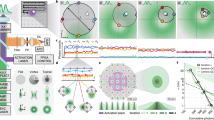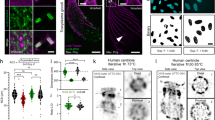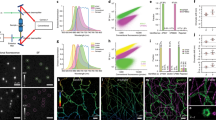Abstract
The ability to directly visualize nanoscopic cellular structures and their spatial relationship in all three dimensions will greatly enhance our understanding of molecular processes in cells. Here we demonstrated multicolor three-dimensional (3D) stochastic optical reconstruction microscopy (STORM) as a tool to quantitatively probe cellular structures and their interactions. To facilitate STORM imaging, we generated photoswitchable probes in several distinct colors by covalently linking a photoswitchable cyanine reporter and an activator molecule to assist bioconjugation. We performed 3D localization in conjunction with focal plane scanning and correction for refractive index mismatch to obtain whole-cell images with a spatial resolution of 20–30 nm and 60–70 nm in the lateral and axial dimensions, respectively. Using this approach, we imaged the entire mitochondrial network in fixed monkey kidney BS-C-1 cells, and studied the spatial relationship between mitochondria and microtubules. The 3D STORM images resolved mitochondrial morphologies as well as mitochondria-microtubule contacts that were obscured in conventional fluorescence images.
This is a preview of subscription content, access via your institution
Access options
Subscribe to this journal
Receive 12 print issues and online access
$259.00 per year
only $21.58 per issue
Buy this article
- Purchase on Springer Link
- Instant access to full article PDF
Prices may be subject to local taxes which are calculated during checkout




Similar content being viewed by others
References
Hell, S.W. Far-field optical nanoscopy. Science 316, 1153–1158 (2007).
Gustafsson, M.G.L. Nonlinear structured-illumination microscopy: wide-field fluorescence imaging with theoretically unlimited resolution. Proc. Natl. Acad. Sci. USA 102, 13081–13086 (2005).
Schmidt, R. et al. Spherical nanosized focal spot unravels the interior of cells. Nat. Methods 5, 539–544 (2008).
Rust, M.J., Bates, M. & Zhuang, X.W. Sub-diffraction-limit imaging by stochastic optical reconstruction microscopy (STORM). Nat. Methods 3, 793–795 (2006).
Betzig, E. et al. Imaging intracellular fluorescent proteins at nanometer resolution. Science 313, 1642–1645 (2006).
Hess, S.T., Girirajan, T.P.K. & Mason, M.D. Ultra-high resolution imaging by fluorescence photoactivation localization microscopy. Biophys. J. 91, 4258–4272 (2006).
Egner, A. et al. Fluorescence nanoscopy in whole cells by asynchronous localization of photoswitching emitters. Biophys. J. 93, 3285–3290 (2007).
Huang, B., Wang, W.Q., Bates, M. & Zhuang, X.W. Three-dimensional super-resolution imaging by stochastic optical reconstruction microscopy. Science 319, 810–813 (2008).
Juette, M.F. et al. Three-dimernsional sub-100 nm resolution fluorescence microscopy of thick samples. Nat. Methods 5, 527–529 (2008).
Schermelleh, L. et al. Subdiffraction multicolor imaging of the nuclear periphery with 3D structured illumination microscopy. Science 320, 1332–1336 (2008).
Donnert, G. et al. Two-color far-field fluorescence nanoscopy. Biophys. J. 92, L67–L69 (2007).
Bates, M., Huang, B., Dempsey, G.T. & Zhuang, X.W. Multicolor super-resolution imaging with photo-switchable fluorescent probes. Science 317, 1749–1753 (2007).
Bock, H. et al. Two-color far-field fluorescence nanoscopy based on photoswitchable emitters. Appl. Phys. B-Lasers Opt. 88, 161–165 (2007).
Shroff, H. et al. Dual-color superresolution imaging of genetically expressed probes within individual adhesion complexes. Proc. Natl. Acad. Sci. USA 104, 20308–20313 (2007).
Bates, M., Blosser, T.R. & Zhuang, X.W. Short-range spectroscopic ruler based on a single-molecule optical switch. Phys. Rev. Lett. 94, 108101 (2005).
Conley, N.R., Biteen, J.S. & Moerner, W.E. Cy3-Cy5 covalent heterodimers for single-molecule photoswitching. J. Phys. Chem. B 112, 11878–11880 (2008).
Neupert, W. & Herrmann, J.M. Translocation of proteins into mitochondria. Annu. Rev. Biochem. 76, 723–749 (2007).
Kao, H.P. & Verkman, A.S. Tracking of single fluorescent particles in 3 dimensions - use of cylindrical optics to encode particle position. Biophys. J. 67, 1291–1300 (1994).
Hell, S., Reiner, G., Cremer, C. & Stelzer, E.H.K. Aberrations in confocal fluorescence microscopy induced by mismatches in refractive-index. J. Microsc. 169, 391–405 (1993).
Chan, D.C. Mitochondria: Dynamic organelles in disease, aging, and development. Cell 125, 1241–1252 (2006).
Frazier, A.E., Kiu, C., Stojanovski, D., Hoogenraad, N.J. & Ryan, M.T. Mitochondrial morphology and distribution in mammalian cells. Biol. Chem. 387, 1551–1558 (2006).
Taguchi, N., Ishihara, N., Jofuku, A., Oka, T. & Mihara, K. Mitotic phosphorylation of dynamin-related GTPase Drp1 participates in mitochondrial fission. J. Biol. Chem. 282, 11521–11529 (2007).
Gao, W., Pu, Y., Luo, K.Q. & Chang, D.C. Temporal relationship between cytochrome c release and mitochondrial swelling during UV-induced apoptosis in living HeLa cells. J. Cell Sci. 114, 2855–2862 (2001).
Anesti, V. & Scorrano, L. The relationship between mitochondrial shape and function and the cytoskeleton. Biochim. Biophys. Acta-Bioenerg. 1757, 692–699 (2006).
Boldogh, I.R. & Pon, L.A. Mitochondria on the move. Trends Cell Biol. 17, 502–510 (2007).
Frederick, R.L. & Shaw, J.M. Moving mitochondria: Establishing distribution of an essential organelle. Traffic 8, 1668–1675 (2007).
Enderlein, J., Toprak, E. & Selvin, P.R. Polarization effect on position accuracy of fluorophore localization. Opt. Express 14, 8111–8120 (2006).
Chen, I., Howarth, M., Lin, W.Y. & Ting, A.Y. Site-specific labeling of cell surface proteins with biophysical probes using biotin ligase. Nat. Methods 2, 99–104 (2005).
Fernandez-Suarez, M. et al. Redirecting lipoic acid ligase for cell surface protein labeling with small-molecule probes. Nat. Biotechnol. 25, 1483–1487 (2007).
Popp, M.W., Antos, J.M., Grotenbreg, G.M., Spooner, E. & Ploegh, H.L. Sortagging: a versatile method for protein labeling. Nat. Chem. Biol. 3, 707–708 (2007).
Acknowledgements
This work is supported by in part by the US National Institutes of Health (to X.Z.). X.Z. is a Howard Hughes Medical Institute Investigator.
Author information
Authors and Affiliations
Corresponding author
Supplementary information
Supplementary Text and Figures
Supplementary Figures 1-7, Supplementary Data and Supplementary Methods (PDF 2596 kb)
Supplementary Video 1
A 3D presentation of the mitochondria shown in Figure 2a. Different viewing perspectives of the 3D image are presented by rotating the image. In both x-y and x-z viewing perspectives, consecutive 100 nm thick sections are also shown. The x-y sections start from the bottom of the cells toward top and the x-z sections start from the upper part of the image. Scale bar: 3 μm. (MOV 2526 kb)
Supplementary Video 2
A 3D presentation of the mitochondrion and microtubules shown in Figure 3e. Different viewing perspectives of the 3D STORM image (left) are presented by rotating the image. A 3D surface rendered model (right) is also shown to facilitate understanding the spatial relationship between the mitochondrion and microtubules. The model is created by manually tracing the six microtubules and the surface of the mitochondrion in each of the 20 nm thick z sections (30 sections in total), a method that is commonly used in modeling of electron microscopy tomography data. The individual surface segments were then 3D rendered by using the ImageSurfer software (http://www.imagesurfer.org). (MOV 2007 kb)
Rights and permissions
About this article
Cite this article
Huang, B., Jones, S., Brandenburg, B. et al. Whole-cell 3D STORM reveals interactions between cellular structures with nanometer-scale resolution. Nat Methods 5, 1047–1052 (2008). https://doi.org/10.1038/nmeth.1274
Received:
Accepted:
Published:
Issue Date:
DOI: https://doi.org/10.1038/nmeth.1274
This article is cited by
-
Spectroscopic single-molecule localization microscopy: applications and prospective
Nano Convergence (2023)
-
Scanning single molecule localization microscopy (scanSMLM) for super-resolution volume imaging
Communications Biology (2023)
-
Super-resolution multicolor fluorescence microscopy enabled by an apochromatic super-oscillatory lens with extended depth-of-focus
Nature Communications (2023)
-
MAxSIM: multi-angle-crossing structured illumination microscopy with height-controlled mirror for 3D topological mapping of live cells
Communications Biology (2023)
-
Tetra-color superresolution microscopy based on excitation spectral demixing
Light: Science & Applications (2023)



